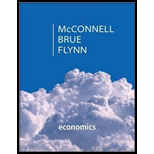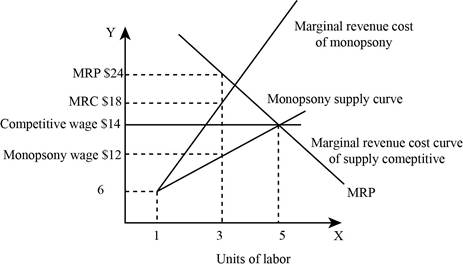
Concept explainers
Sub part (a):
The monopsony market.
Sub part (a):
Explanation of Solution
The total labor cost can be calculated by using the following formula.
Substitute the respective value in the equation (1) to calculate the total labor cost at one unit of labor.
The total labor cost is $3.
The marginal resource cost can be calculated by using the following formula.
Substitute the respective values in the equation (2) to calculate the marginal resource cost at one unit of labor.
The marginal resource cost is $3.
Table -1 shows the value of the total labor cost and the marginal resources cost that are obtained by using the equation (1) and (2).
Table -1
| Units of labor | Wage rate | Total labor cost | Marginal resources cost |
| 0 | - | 0 | |
| 1 | 6 | 6 | 6 |
| 2 | 9 | 18 | 12 |
| 3 | 12 | 36 | 18 |
| 4 | 15 | 60 | 24 |
| 5 | 18 | 90 | 30 |
| 6 | 21 | 120 | 36 |
The total revenue can be calculated by using the following formula.
The
Substitute the respective value in the equation (3) to calculate the total revenue at one unit of labor.
The total revenue is $34.
The marginal product can be calculated by using the following formula.
Substitute the respective values in the equation (4) to calculate the marginal resource cost at one unit of labor.
The marginal product is $17.
The marginal revenue product can be calculated by using the following formula.
The
Substitute the respective values in the equation (5) to calculate the marginal revenue product.
The marginal revenue product is $34.
Table -2 shows the value of the total revenue, the marginal revenue product and the marginal product that is obtained by using the equation (3), (4) and (5).
Table -2
| Units of labor | Total product | Marginal product | Product price | Total revenue | Marginal revenue product |
| 0 | 0 | 2 | 0 | ||
| 1 | 17 | 17 | 2 | 34 | 34 |
| 2 | 31 | 14 | 2 | 62 | 28 |
| 3 | 43 | 12 | 2 | 86 | 24 |
| 4 | 53 | 10 | 2 | 106 | 20 |
| 5 | 60 | 7 | 2 | 120 | 14 |
| 6 | 65 | 5 | 2 | 130 | 10 |
Graph -1 shows the firms labor supply and the marginal resources cost.7

In graph -1, the horizontal axis measures the units of labor and the vertical axis represents the wage rate. The discrete nature of problem requires that the (MRP) marginal revenue product should be equal or greater than the marginal resources cost. This marginal revenue cost curve lies above the labor supply because the employing of the next worker needs a higher wage in the market and will have to pay a higher wage for all the workers.
Concept introduction:
Monopsony: The monopsony market refers to a market which consists of a single buyer who hires a particular type of labor. The workers provide labor to this type of market that has a limited employment opportunity as they need to acquire new skills to be hired. The firm is the wage marker.
Subpart (b):
How many workers should the firm employ.
Subpart (b):
Answer to Problem 3P
The firm should employ 3 workers.
Explanation of Solution
When the marginal revenue product for this worker is greater than the marginal cost, then the firm should employ the workers. From the table, the firm should employ three workers. For the first worker, the marginal revenue product is $34 and the marginal revenue cost is $6. Thus, the firm should employ the first worker. For the second worker, the marginal revenue product is $28 and the marginal revenue cost is $12. So, the firm should employ the second worker. For the third worker, the marginal revenue product is $24 and the marginal revenue cost is $18. So the firm should employ the third worker. But for the fourth worker, the marginal revenue product is $20 and the marginal revenue cost is $24. So, the firm should not employ the forth worker.
Subpart (c):
What happens to the monopolist employment and equilibrium wage rate.
Subpart (c):
Explanation of Solution
In this, the monopolist employment decreases by 2 units and the equilibrium wage rate is $2 which is less than the competitive wage.
Want to see more full solutions like this?
Chapter 17 Solutions
ECONOMICS W/CONNECT+20 >C<
- As indicated in the attached image, U.S. earnings for high- and low-skill workers as measured by educational attainment began diverging in the 1980s. The remaining questions in this problem set use the model for the labor market developed in class to walk through potential explanations for this trend. 1. Assume that there are just two types of workers, low- and high-skill. As a result, there are two labor markets: supply and demand for low-skill workers and supply and demand for high-skill workers. Using two carefully drawn labor-market figures, show that an increase in the demand for high skill workers can explain an increase in the relative wage of high-skill workers. 2. Using the same assumptions as in the previous question, use two carefully drawn labor-market figures to show that an increase in the supply of low-skill workers can explain an increase in the relative wage of high-skill workers.arrow_forwardPublished in 1980, the book Free to Choose discusses how economists Milton Friedman and Rose Friedman proposed a one-sided view of the benefits of a voucher system. However, there are other economists who disagree about the potential effects of a voucher system.arrow_forwardThe following diagram illustrates the demand and marginal revenue curves facing a monopoly in an industry with no economies or diseconomies of scale. In the short and long run, MC = ATC. a. Calculate the values of profit, consumer surplus, and deadweight loss, and illustrate these on the graph. b. Repeat the calculations in part a, but now assume the monopoly is able to practice perfect price discrimination.arrow_forward
- how commond economies relate to principle Of Economics ?arrow_forwardCritically analyse the five (5) characteristics of Ubuntu and provide examples of how they apply to the National Health Insurance (NHI) in South Africa.arrow_forwardCritically analyse the five (5) characteristics of Ubuntu and provide examples of how they apply to the National Health Insurance (NHI) in South Africa.arrow_forward

 Principles of Economics 2eEconomicsISBN:9781947172364Author:Steven A. Greenlaw; David ShapiroPublisher:OpenStax
Principles of Economics 2eEconomicsISBN:9781947172364Author:Steven A. Greenlaw; David ShapiroPublisher:OpenStax Managerial Economics: Applications, Strategies an...EconomicsISBN:9781305506381Author:James R. McGuigan, R. Charles Moyer, Frederick H.deB. HarrisPublisher:Cengage Learning
Managerial Economics: Applications, Strategies an...EconomicsISBN:9781305506381Author:James R. McGuigan, R. Charles Moyer, Frederick H.deB. HarrisPublisher:Cengage Learning Principles of MicroeconomicsEconomicsISBN:9781305156050Author:N. Gregory MankiwPublisher:Cengage Learning
Principles of MicroeconomicsEconomicsISBN:9781305156050Author:N. Gregory MankiwPublisher:Cengage Learning Microeconomics: Private and Public Choice (MindTa...EconomicsISBN:9781305506893Author:James D. Gwartney, Richard L. Stroup, Russell S. Sobel, David A. MacphersonPublisher:Cengage Learning
Microeconomics: Private and Public Choice (MindTa...EconomicsISBN:9781305506893Author:James D. Gwartney, Richard L. Stroup, Russell S. Sobel, David A. MacphersonPublisher:Cengage Learning





